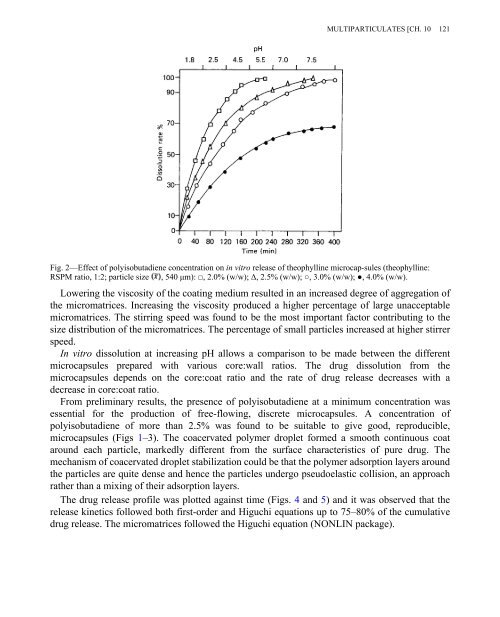Pharmaceutical Technology: Controlled Drug Release, Volume 2
Pharmaceutical Technology: Controlled Drug Release, Volume 2
Pharmaceutical Technology: Controlled Drug Release, Volume 2
Create successful ePaper yourself
Turn your PDF publications into a flip-book with our unique Google optimized e-Paper software.
MULTIPARTICULATES [CH. 10 121<br />
Fig. 2—Effect of polyisobutadiene concentration on in vitro release of theophylline microcap-sules (theophylline:<br />
RSPM ratio, 1:2; particle size , 540 µm): □, 2.0% (w/w); ∆, 2.5% (w/w); ○, 3.0% (w/w); ●, 4.0% (w/w).<br />
Lowering the viscosity of the coating medium resulted in an increased degree of aggregation of<br />
the micromatrices. Increasing the viscosity produced a higher percentage of large unacceptable<br />
micromatrices. The stirring speed was found to be the most important factor contributing to the<br />
size distribution of the micromatrices. The percentage of small particles increased at higher stirrer<br />
speed.<br />
In vitro dissolution at increasing pH allows a comparison to be made between the different<br />
microcapsules prepared with various core:wall ratios. The drug dissolution from the<br />
microcapsules depends on the core:coat ratio and the rate of drug release decreases with a<br />
decrease in core:coat ratio.<br />
From preliminary results, the presence of polyisobutadiene at a minimum concentration was<br />
essential for the production of free-flowing, discrete microcapsules. A concentration of<br />
polyisobutadiene of more than 2.5% was found to be suitable to give good, reproducible,<br />
microcapsules (Figs 1–3). The coacervated polymer droplet formed a smooth continuous coat<br />
around each particle, markedly different from the surface characteristics of pure drug. The<br />
mechanism of coacervated droplet stabilization could be that the polymer adsorption layers around<br />
the particles are quite dense and hence the particles undergo pseudoelastic collision, an approach<br />
rather than a mixing of their adsorption layers.<br />
The drug release profile was plotted against time (Figs. 4 and 5) and it was observed that the<br />
release kinetics followed both first-order and Higuchi equations up to 75–80% of the cumulative<br />
drug release. The micromatrices followed the Higuchi equation (NONLIN package).

















